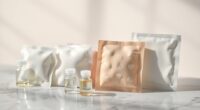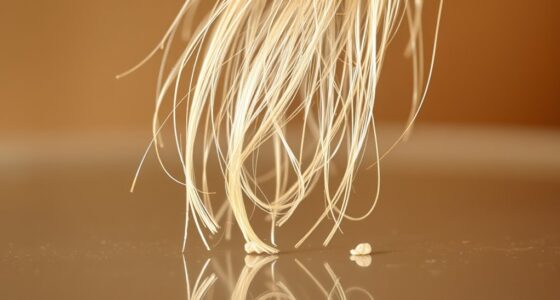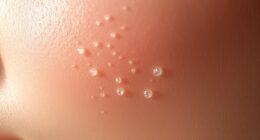Understanding hair porosity is vital for your hair care routine. It determines how well your hair absorbs and retains moisture. With low porosity hair, you’ll struggle with product absorption, while high porosity hair may quickly lose moisture. Knowing your hair’s porosity type allows you to choose the right products and techniques, leading to healthier hair. Curious about how to identify your porosity and optimize your hair care? There’s more to discover about this essential topic.
Key Takeaways
- Hair porosity determines how well your hair absorbs and retains moisture, impacting overall health and styling.
- Different porosity types (low, medium, high) require specific product selections for optimal care and moisture balance.
- Environmental factors and hair treatments can alter porosity, making regular assessment essential for effective hair management.
- Identifying your hair’s porosity helps avoid damage from unsuitable products and enhances the effectiveness of your hair care routine.
- Simple tests, like the cup or spray test, can easily determine your hair’s porosity type at home.

Have you ever wondered why some hair types seem to soak up moisture while others struggle to hold onto it? The answer lies in something called hair porosity, which refers to your hair’s ability to absorb and retain moisture. It’s all about the structure of the hair cuticle, the outermost layer of your hair. This cuticle is made up of overlapping scales that control how moisture penetrates and stays within the hair. Pimple patches can be particularly beneficial for those with high porosity hair, as they can help reduce inflammation and heal blemishes quickly. Additionally, understanding your hair porosity can help you choose the right essential oils, like lavender oil, which is known for its calming effects that may reduce stress-related hair loss.
Understanding hair porosity is key to knowing why some hair types absorb moisture better than others.
Understanding your hair porosity is essential because it directly affects how well products work on your hair and how your styling turns out.
There are three main categories of hair porosity: low, medium, and high. Low porosity hair has tightly closed cuticle scales, making it resistant to moisture absorption. While it retains moisture well, it can be a challenge to get it in there in the first place. Medium porosity hair features slightly raised cuticle scales that allow for a balanced absorption and retention of moisture, making it easier to manage.
On the flip side, high porosity hair has widely open cuticle scales, allowing it to absorb moisture quickly but also leading to rapid moisture loss. This variation in porosity can even exist along different sections of your hair due to damage or treatments.
Several factors influence hair porosity, including genetics, environmental conditions, and the use of heat or chemical treatments. Over time, your hair’s porosity can change, especially if you frequently expose it to harsh elements or neglect proper care routines.
Knowing your hair porosity helps you choose the right products and care techniques for ideal health. For instance, low porosity hair benefits from lightweight products to avoid build-up, while high porosity hair needs intense moisturizing solutions to lock in hydration. Additionally, incorporating yoga practices into your routine can enhance your overall well-being, which may positively affect your hair health.
You can easily test your hair porosity at home. The Cup Test involves putting a strand of hair in water; if it sinks quickly, you likely have high porosity hair. The Spray Test shows how your hair reacts to water—if it beads up, that’s low porosity; quick absorption suggests high porosity.
Understanding your porosity can save you from unnecessary treatments and product build-up. Ultimately, managing your hair effectively starts with knowing its porosity. By selecting the right products and techniques tailored to your specific hair type, you can achieve healthier, more manageable hair.
Frequently Asked Questions
Can Hair Porosity Change Over Time?
Yes, hair porosity can change over time.
You might notice that your hair becomes more porous due to damage from coloring, heat styling, or environmental factors. When the hair cuticle opens up, it allows moisture in but can struggle to retain it.
Conversely, low porosity hair can become more porous from chemical treatments.
Adjusting your hair care routine and using the right products can help manage these changes effectively.
How Can I Test My Hair Porosity at Home?
Imagine you’re standing in the bathroom, ready to test your hair porosity. You grab a strand and fill a glass with water.
Drop your hair in; if it sinks, you’ve got high porosity, while floating means low porosity.
Alternatively, mist your hair with water—if it absorbs quickly, it’s high porosity.
These simple tests help you understand your hair’s needs, allowing you to choose the right products for ideal health and styling.
What Products Are Best for High Porosity Hair?
For high porosity hair, choose products that lock in moisture and protect your strands.
Look for hydrating shampoos and conditioners rich in oils like coconut or shea butter. Incorporate deep conditioning treatments and leave-in conditioners for extra hydration.
Use frizz control serums to smooth your hair, and always apply heat protectants before styling.
Opt for satin pillowcases to minimize moisture loss while you sleep and maintain your hair’s natural shine.
Does Hair Porosity Affect Hair Color Results?
Imagine pouring a glass of water onto a sponge. If it’s too porous, it soaks up quickly but leaks just as fast.
Your hair works similarly with color. If you’ve got high porosity, your hair absorbs dye quickly but fades just as fast, leaving you with dull results.
Low porosity? It resists color, making it hard to achieve that vibrant hue.
Understanding this helps you tailor your coloring approach for the best results.
Can Diet Influence My Hair Porosity?
Yes, your diet can definitely influence your hair porosity. A balanced diet rich in vitamins, minerals, and healthy fats supports hair health, making it easier for moisture to penetrate and stay locked in.
On the other hand, excessive sugar, unhealthy fats, and nutritional deficiencies can disrupt this balance, leading to increased porosity.
Conclusion
Understanding hair porosity is like discovering the secret passage to your hair’s healthiest self. By knowing whether your strands drink up moisture like a sponge or resist it like a fortress, you can tailor your hair care routine to suit its unique needs. Imagine your hair flourishing, vibrant and full of life, as you nurture it with the right products. So, embrace this knowledge, and watch your locks transform into the luscious, radiant mane you’ve always dreamed of.










